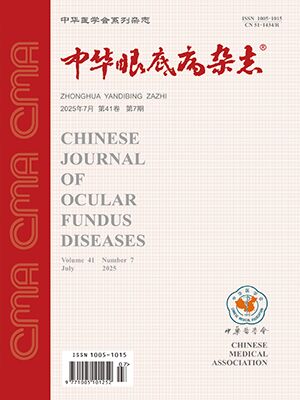| 1. |
Daruich A, Matet A, Dirani A, et al. Central serous chorioretinopathy: recent findings and new physiopathology hypothesis[J]. Prog Retin Eye Res, 2015, 48: 82-118. DOI: 10.1016/j.preteyeres.2015.05.003.
|
| 2. |
Loo RH, Scott IU, Flynn HW Jr, et al. Factors associated with reduced visual acuity during long-term follow-up of patients with idiopathic central serous chorioretinopathy[J]. Retina, 2002, 22(1): 19-24. DOI: 10.1097/00006982-200202000-00004.
|
| 3. |
Eandi CM, Ober M, Iranmanesh R, et al. Acute central serous chorioretinopathy and fundus autofluorescence[J]. Retina, 2005, 25(8): 989-993. DOI: 10.1097/00006982-200512000-00006.
|
| 4. |
Teussink MM, Breukink MB, van Grinsven MJ, et al. OCT angiography compared to fluorescein and indocyanine green angiography in chronic central serous chorioretinopathy[J]. Invest Ophthalmol Vis Sci, 2015, 56(9): 5229-5237. DOI: 10.1167/iovs.15-17140.
|
| 5. |
Chan SY, Wang Q, Wei WB, et al. Optical coherence tomographic angiography in central serous chorioretinopathy[J]. Retina, 2016, 36(11): 2051-2058. DOI: 10.1097/iae.0000000000001064.
|
| 6. |
van Rijssen TJ, van Dijk EHC, Yzer S, et al. Central serous chorioretinopathy: towards an evidence-based treatment guideline[J/OL]. Prog Retin Eye Res, 2019, 73: 100770[2019-07-15]. https://linkinghub.elsevier.com/retrieve/pii/S1350-9462(18)30094-6. DOI: 10.1016/j.preteyeres.2019.07.003.
|
| 7. |
Treatment of Age-related Macular Degeneration With Photodynamic Therapy (TAP) Study Group. Photodynamic therapy of subfoveal choroidal neovascularization in age-related macular degeneration with verteporfin: one-year results of 2 randomized clinical trials-TAP report. Treatment of age-related macular degeneration with photodynamic therapy (TAP) Study Group[J]. Arch Ophthalmol, 1999, 117(10): 1329-1345. DOI: 10.1001/archopht.117.10.1329.
|
| 8. |
Fujita K, Imamura Y, Shinoda K, et al. One-year outcomes with half-dose verteporfin photodynamic therapy for chronic central serous chorioretinopathy[J]. Ophthalmology, 2015, 122(3): 555-561. DOI: 10.1016/j.ophtha.2014.09.034.
|
| 9. |
Zhao M, Zhang F, Chen Y, et al. A 50% vs 30% dose of verteporfin (photodynamic therapy) for acute central serous chorioretinopathy: one-year results of a randomized clinical trial[J]. JAMA Ophthalmol, 2015, 133(3): 333-340. DOI: 10.1001/jamaophthalmol.2014.5312.
|
| 10. |
Costanzo E, Cohen SY, Miere A, et al. Optical coherence tomography angiography in central serous chorioretinopathy[J/OL]. J Ophthalmol, 2015, 2015: 134783[2015-11-08]. https://europepmc.org/article/MED/26634150. DOI:10.1155/2015/134783.
|
| 11. |
Hu J, Qu J, Piao Z, et al. Optical coherence tomography angiography compared with indocyanine green angiography in central serous chorioretinopathy[J]. Sci Rep, 2019, 9(1): 6149. DOI: 10.1038/s41598-019-42623-x.
|
| 12. |
Hu J, Qu J, Li M, et al. Optical coherence tomography angiography-guided photodynamic therapy for acute central serous chorioretinopathy[J]. Retina, 2021, 41(1): 189-198. DOI: 10.1097/iae.0000000000002795.
|
| 13. |
Yu J, Jiang C, Xu G. Correlations between changes in photoreceptor layer and other clinical characteristics in central serous chorioretinopathy[J]. Retina, 2019, 39(6): 1110-1116. DOI: 10.1097/iae.0000000000002092.
|
| 14. |
Pichai J, Vanchalerm B, Mansing R. One-year results of half-dose versus one-third-dose photodynamic therapy in chronic or recurrent central serous chorioretinopathy[J]. BMC Ophthalmol, 2021, 21(1): 30. DOI: 10.1186/s12886-020-01796-0.
|
| 15. |
Spaide RF, Gemmy Cheung CM, Matsumoto H, et al. Venous overload choroidopathy: a hypothetical framework for central serous chorioretinopathy and allied disorders[J/OL]. Prog Retin Eye Res, 2022, 86: 100973[2021-05-21]. https://linkinghub.elsevier.com/retrieve/pii/S1350-9462(21)00034-3. DOI: 10.1016/j.preteyeres.2021.100973.
|




